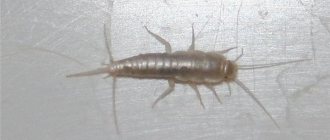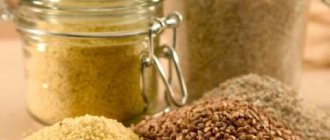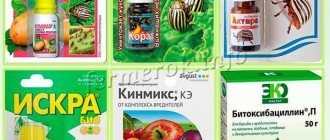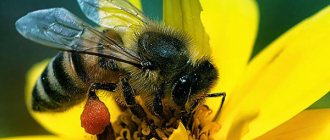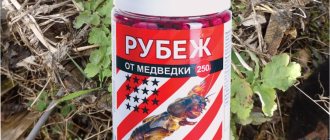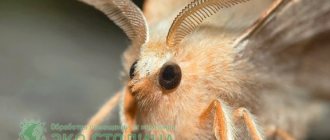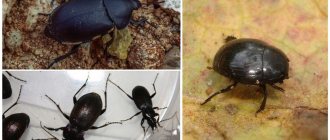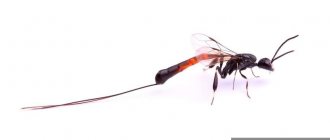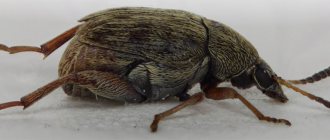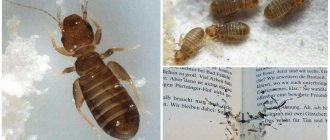Various worms in the apartment are not uncommon; they can be found in the bathroom, in the kitchen, under the carpet and even in your own bed. The reasons for the appearance of worms are always different; even in an exemplarily clean apartment they can be seen in the most unexpected place. For example, you take out cereal to cook porridge, and there are worms swarming in the bag, or you change the bed linen, you lift the sheet, and nasty insects crawl across the bed. In any case, other than a feeling of disgust, and maybe even fear, you will not experience. I want to get rid of the misfortune as quickly as possible, but before doing this, you need to know who you will have to fight with, otherwise there is a risk of losing the war. More often than not, worms are insect larvae; let's take a closer look at who might live next door to you.
Worms in the sofa
White or yellowish caterpillars in the sofa are most likely furniture moth larvae. They can be distinguished from other pests by their cocoon, an almost entire house that they construct from the remains of fabric, excrement and silk. The worm puts it on himself and moves like this, albeit over short distances.
Furniture moth larva – photo
The furniture moth (its larva) develops at a temperature of 23-25°C for about 90 days. They do not like illuminated surfaces, so worms may not be noticed for a long time in the cracks and folds of upholstered furniture. Each of the caterpillars can significantly damage the upholstery of furniture, so pests need to be destroyed as quickly as possible. Look behind the sofa, you may find entire nests of moths there.
Tiny, white, translucent worms with sparse hair that can be seen under a magnifying glass are flea larvae. Fleas feel great on the sofa and you don’t have to go far for food. They do not bite humans; the larvae feed on organic matter (and there are many particles of your skin in the sofa), excrement of adult insects, and plant remains.
Flea larva - photo
If you place the larva under a microscope, you can see its esophagus with food that has not yet been digested and the remains of organic matter. The size of flea larvae is only about 2-5 millimeters. They have 13 segments, a round head and well-developed jaws. The larva develops in a period from 9 days to several months, it all depends on the temperature and availability of food. They can go hungry for a very long time, up to one month. They also choose unlit places, hiding in folds and crevices. In this case, you need to think about how to remove fleas from your apartment, because after they grow up, they will begin to drink your blood. You can also find flea larvae in animal bedding, closets, heaps of garbage, and even in a box with vegetables.
Danger and harm
All of the above insects and arthropods have an extremely unpleasant appearance and can provoke severe fear in an impressionable person. But very few of them are considered dangerous.
Woodlice, for example, have mouthparts that are not at all designed for biting. Therefore, in this regard, there is no need to fear them. They do not encroach on food or damage household items, but can serve as carriers of pathogenic bacteria and fungi.
Silverfish are absolutely safe for humans or pets. They do not carry pathogens of any diseases and are not capable of causing harm by violating the integrity of the skin.
However, it is absolutely necessary to get rid of them. These insects spoil textiles, books and photographs.
For a home library, for example, just 20–30 silverfish can become a real disaster.
A variety of centipedes called kiwsyak is also safe for humans . They do not cause any damage to furniture, wallpaper or textiles.
Flycatchers lead a predatory lifestyle, eating other insects and arthropods, so they are not at all interested in human food. They are also not carriers of pathogens and fungi.
In a sense, flycatchers are even useful for humans, as they exterminate flies, mosquitoes and cockroaches. The only danger posed by this arthropod is bites. The flycatcher itself will never attack a person first, but in defense it may well contrive and bite through the skin, injecting poison.
The sensation of such a sting can be compared to how a bee stings, but in people prone to allergic reactions, the site of injury may become very red and increase in size due to swelling.
Curious pets can also suffer from flycatcher bites. Dogs, for example, are often bitten on the nose by arthropods, which can cause the unfortunate animal to suffer greatly.
Butterflies are not carriers of diseases and are not capable of biting either humans or animals. However, the proximity to them can hardly be called pleasant, and for allergy sufferers it is completely unacceptable.
While visiting a friend, I noticed elongated, nimble creatures in the bathroom, which, upon closer inspection, turned out to be woodlice. Previously, I had only seen such insects in the forest, where they can often be seen on rotten stumps and near streams and puddles. A friend said that she had been unsuccessfully fighting them for six months, trying to get rid of them completely. It turns out that the neighbors in the entrance often complain about woodlice scurrying around the bathroom, but all efforts to destroy them are in vain, since they enter the apartment from the ventilation holes. After several residents contacted the management company servicing the building with a collective request to carry out pest control treatment of the basement, the number of unpleasant neighbors decreased sharply. In addition, careful sealing of pipes and cracks in the floor, from which nasty woodlice appeared, helped.
Worms in the mattress (pillow, bed)
If you find a damaged mattress or pillow, examine the bedding for the presence of small light-colored worms - clothes moth larvae. Calling them worms is not very correct, because the caterpillar has, albeit tiny, six pairs of limbs. The clothes moth (larva), just like a furniture moth, makes a cover, constructing it from fabric and a certain substance of its own, reminiscent of silk.
Clothes moth larva – photo
With normal nutrition and optimal temperature, the larva develops in two months, and with a drop in temperature in five months. Caterpillars have a length from 1 to 12 mm; interestingly, they cannot drink, so they prefer damp areas of fabric - greasy stains, food debris, sweat. House moth larvae can be found in closets with clothes, in carpets, and other dark places.
What is pinworm
The pinworm is a roundworm that parasitizes the human body and is a type of nematode . Both humans and great apes suffer from these parasites (helminths). The disease they cause is called enterobiasis . Both children (mostly) and adults are susceptible to it.
The body of the worm is round in cross-section, up to 1.5 cm , grayish or white in color, tapering towards the ends. The worms live mainly in the small intestine (in the cecum they can cause appendicitis), and the individuals are dioecious.
Fertilization occurs in the ileum. Upon completion, the males die, and the female emerges through the anus to the surface of the body, lays eggs and also dies. The entire life of the parasite lasts about a month.
Worms in the carpet
In the carpet beetle, the leather beetle, the larvae look like oval, semi-cylindrical or spindle-shaped worms. The larvae are mobile, their body has brown stripes and is covered with stiff, protruding hairs.
Kozheed beetle larva – photo
The leather beetle is found not only in carpets; they are attracted to feathers, fur, upholstered furniture and even clothing. Lately, skin beetles have been found quite often.
Treatment Options
If the diagnosis is confirmed, treatment should begin immediately. For adults and children, the methods are similar, but have their own characteristics:
- For adult patients, procedures can be performed at home with the help of medications. The most effective drugs: vermox , mebex , helmitox , nemozol (use after consulting a doctor). Drug treatment should be combined with preventive measures (sterilization of linen, cleaning, sanitation) and diet (laxatives, foods that are easy on the stomach). It is advisable to repeat the course of treatment after 10-14 days. To relieve the itching sensation, antiallergenic drugs (suprastin, cetrin) are suitable.
- Children are most susceptible to the disease, so you need to be very careful when symptoms appear in order to take timely action. If they appear, you should immediately contact a medical facility. Delay can have a serious impact on the health and development of the child. Treatment, in general, is no different, but the dosage of medications and the conditions for keeping the patient are different.
In young girls, pinworm infection may be accompanied by urinary incontinence.
There are folk remedies that help expel worms (pinworms):
- Pumpkin seeds are a centuries-old remedy. Microelements and their combinations contained in pumpkin seeds, as well as substances formed during digestion, are intolerable to parasites.
- Another proven remedy is garlic . But it must be used taking into account the condition of the patient’s gastrointestinal tract (excluded in case of gastritis and ulcers).
But simple preventive measures will help prevent the disease.
Worms in cabinet furniture
The main pest of wood is the wood borer beetle. Its larvae live in wood products, in particular in furniture, for a very long time, up to 17 years!
Grinder beetle larva – photo
During its lifetime, just one larva can gnaw passages up to 40 kilometers long in wood. The larvae are white, fleshy, 5-10mm long. They have thickened segments on the chest, small dark spines on the back, and three pairs of thoracic legs. Adult insects fly out. Wood-boring beetles can live in your home for several years without being noticed.
How to find out if a person has worms at home
The presence of worms in the body cannot be determined visually. But there are characteristic symptoms that may indicate infection:
- drowsiness, chronic fatigue, malaise;
- frequent diarrhea or constipation, vomiting, nausea;
- weakened immunity, regular colds;
- sudden onset of allergies;
- sudden, causeless weight loss.
In children, the presence of worms is characterized by the following symptoms:
- poor sleep, grinding teeth in sleep;
- frequent diarrhea, vomiting, flatulence;
- excessive saliva production;
- itching in the anal area;
- irritability, drowsiness;
- brittle nails, hair and dry skin.
However, these signs are not specific to worm infection and may accompany other pathologies.
Therefore, consultation with a doctor is mandatory. You need to contact an infectious disease specialist and gastroenterologist. Laboratory tests of stool, smear, and blood help to make an accurate diagnosis and find out which worms have infected the body.
Worms in the bathroom or toilet
Not very much, but still similar to white or silvery silverfish worms that prefer dampness.
Silverfish - photo
The length of the insect is 1-2 cm, the body is more like a droplet. Silverfish do not like light, preferring to hide in cracks in the floor, furniture and other dark places. Pests are found not only in bathrooms, they can be found under carpets, in furniture, under baseboards, it all depends on the level of humidity in your apartment. The silverfish lives for 4 years. You can get to know the pest better and find out how to get rid of them here - “Silverfish - how to get rid of insects.”
Causes of insects
The main reason for the appearance of unpleasant visitors in the bathroom and toilet is high humidity and stable heat. This atmosphere is loved by woodlice, silverfish, and centipedes. Butterflies are attracted by the rotting of organic matter in the sewer and the opportunity to breed numerous offspring there.
Insects and arthropods enter the bathroom and toilet through ventilation holes in the walls, from basements through cracks and through sewer pipes. Having entered the home, unpleasant guests begin to multiply vigorously and soon populate all suitable places.
The last floor is just as dangerous in terms of pest infestation as the first floor. The fact is that attic spaces are heated by the sun in summer, and during rains moisture gets inside through holes in the roof. This creates favorable conditions for the life and reproduction of insects.
Habitats
The most common habitats for insects and arthropods in the bathroom and toilet are:
- pipes on which condensate accumulates,
- secluded and unlit corners (behind the washing machine, under the bathtub, behind the toilet, etc.),
- wet rags,
- puddles under the bathtub near the leak area,
- in cabinets filled with boxes and bottles of cleaning products.
Worms in the kitchen
Small white worms in cereals are food moths that also eat flour, dried fruits and even animal feed.
Moth larvae create cocoons in the form of lumps, for example, as in the photo.
Food moths in an apartment, or rather its larvae, easily gnaw through bags where food is stored, not only eat them, but also infect them with feces, dead individuals, and skin. Thus, eating contaminated foods is not recommended. Most often, it gets into the house along with groceries from the store, but not only does it not survive, you can find a moth larva in the most unexpected corner of the apartment.
In unsanitary conditions, fly larvae appear in the kitchen, which look like white worms.
Fly larva – photo
The length of the larvae reaches 13 mm. The worm has no legs, its shape is truncated at the back, and pointed at the front, where the mouth opening is located. They live in a semi-liquid environment from three to twenty-five days, and then crawl away to a cool, dry place and pupate.
Perhaps this is the majority of all the worms that you can find in your apartment. There are still many different larvae and even worms that accidentally end up in a person’s home. If you haven’t found a specimen like yours, send a photo and we will definitely answer your questions about who has settled in your home and how to deal with them.
Prevention
This procedure includes the following techniques:
- Remove non-perishable food items from the kitchen. It is best to store cereals and cereals in the pantry or on the balcony. Cold air will stop the larvae from breeding. In cases where products of this type show signs of contamination, they must be treated thermally. The easiest option is to bake them in the oven.
- Do not store flour, sugar and cereals in large quantities in a room not equipped for this purpose. It is recommended to buy such products in small quantities that will be used up quickly.
- To increase the effectiveness of preventive measures, it is recommended to use proven traditional methods. As experts say, food moths do not tolerate sharp and pungent odors. To scare it away, place dried wormwood, mint or geranium inside kitchen cabinets.
- Another folk method is to use various spices (cloves, bay leaves or allspice) to fight moths. They are laid out in rag bags on grocery shelves.
However, you should not limit yourself only to folk methods, because they do not always bring the desired effect in the fight against worms on the ceiling.
Diet for helminthiasis
The menu of a patient with helminthiasis should include the following products:
- Antiparasitic products (garlic, onion, pomegranate, pumpkin seeds);
- Fiber (beets, flax seeds);
- Dairy products.
Exclude:
- Alcohol, coffee;
- Sugar;
- Fatty foods;
- Meat and fish;
- Starchy foods.
It is necessary to drink a lot of water, and heat all food, including fruits.
Coffee
Coffee enemas are used to get rid of parasites. You will need a liter of water and 3 tbsp. l. coffee, it must be natural. Coffee is poured into water and put on fire. Having brought to a boil, reduce the heat and finally turn off after 15 minutes. The resulting composition must be cooled, strained thoroughly and used as an enema. It is advisable that the solution remains in the intestines for at least 20 minutes. The course is two weeks, once a day before bedtime.
Hydrogen peroxide
Hydrogen peroxide is widely used in medicine in a variety of situations, and infection with worms is no exception. As practice shows, positive dynamics are noticeable already on the third day of treatment. But the product is still toxic, so it must be used extremely carefully, strictly following the prescribed dosage. The application regimen looks like this: 1 drop of peroxide per 50 ml of clean water (non-chlorinated!). The solution is taken half an hour before meals. Every day you need to add one drop until there are 10. Then they take a break for three days, and the second stage (three days) begins with 10 drops. Then again a break of three days.
For children, the dosage is reduced exactly by half, and the dose is reduced to one per day.
Pumpkin seeds
Pumpkin seeds are unique in that they contain cucurbitin. This substance has toxic properties, and the thin green film between the core and shell contains the maximum amount of cucurbitin, and the core itself has little of it. Once in the human intestines, pumpkin seeds poison small worms (up to 5 cm). You can eat up to 300 grams of pumpkin seeds per day.
